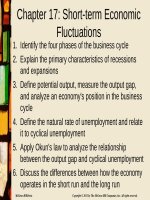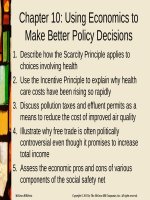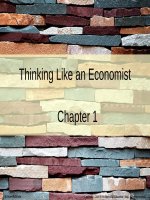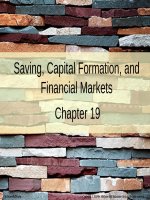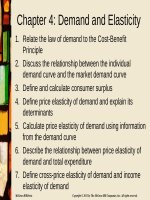Lecture Principles of economics (Brief edition, 2e): Chapter 17 - Robert H. Frank, Ben S. Bernanke
Bạn đang xem bản rút gọn của tài liệu. Xem và tải ngay bản đầy đủ của tài liệu tại đây (255.91 KB, 13 trang )
Chapter 17: Short-term Economic
Fluctuations
1. Identify the four phases of the business cycle
2. Explain the primary characteristics of recessions
and expansions
3. Define potential output, measure the output gap,
and analyze an economy's position in the business
cycle
4. Define the natural rate of unemployment and relate
it to cyclical unemployment
5. Apply Okun's law to analyze the relationship
between the output gap and cyclical unemployment
6. Discuss the differences between how the economy
operates in the short run and the long run
McGrawHill/Irwin
Copyright © 2011 by The McGrawHill Companies, Inc. All rights reserved.
Recessions and Expansions
• Business Cycles are short-term fluctuations in
GDP and other variables
• A recession (or contraction) is a period in
which the economy is growing at a rate
significantly below normal
– A period during which real GDP falls for two or more
consecutive quarters
– A period during which real GDP growth is well
below normal, even if not negative
– A variety of economic data are examined
• A depression is a particularly severe recession
172
Recessions and Expansions
• A peak is the beginning of a recession
– High point of the business cycle
• A trough is the end of a recession
– Low point of the business cycle
• An expansion is a period in which the economy
is growing at a rate significantly above normal
• A boom is a strong and long lasting expansion
173
Calling the 2007 Recession
• NBER declared a recession December 2007
– Previous recession ended November 2001
– 73 month expansion
• Four important monthly indicators used to date
recessions:
– Industrial production
– Total sales in manufacturing, wholesale, and
retail
– Non-farm employment
– Real after-tax household income
• Coincident indicators move with overall
economy
174
Short-Term Economic
Fluctuations
• Economists have studied business cycles for at
least a century
– Recessions and expansions are irregular in their
length and severity
– Contractions and expansions affect the entire
economy
• May have global impact
– Great Depression of the 1930s was worldwide
– US recessions of 1973 – 1975 and 1981 – 1982
– US recession that began in 2007
175
Symptoms of Business Cycles
• Cyclical unemployment rises sharply during
recessions
–
–
–
–
Decrease in unemployment lags the recovery
Real wages grow more slowly for those employed
Promotions and bonuses are often deferred
New labor market entrants have difficulty finding
work
• Production of durable goods is more volatile
than services and non-durable goods
– Cars, houses, capital equipment less stable
176
Potential Output
• Potential output, Y* , is the maximum sustainable
amount of output that an economy can produce
– Also called full-employment output
– Use capital and labor at greater than normal rates and
exceed Y* – for a period of time
• Potential output grows over time
• Actual output grows at a variable rate
– Reflects growth rate of Y*
• Variable rates of technical innovation, capital
formation, weather conditions, etc.
– Actual output does not always equal potential output
177
Output Gaps
• The output gap is the difference between the
economy’s actual output and its potential output,
relative to potential output, at a point in time
Output gap = [(Y – Y*)/Y*]x100
– Recessionary gap is a negative output gap; Y* > Y
– Expansionary gap is a positive output gap; Y* < Y
• Policy makers consider stabilization policies
when there are output gaps
– Recessionary gaps mean output and employment
are less than their sustainable level
– Expansionary gaps lead to inflation
178
Natural Rate of Unemployment
• Recessionary gaps have high unemployment
rates
– Expansionary gaps have low unemployment rates
• The natural rate of unemployment, u*, is the
sum of frictional and structural unemployment
– Unemployment rate when cyclical unemployment is 0
– Occurs when Y is at Y*
• Cyclical unemployment is the difference between
total unemployment, u, and u*
– Recessionary gaps have u > u*
– Expansionary gaps have u < u*
179
Okun’s Law
• Okun's law relates cyclic unemployment
changes to changes in the output gap
– One percentage point increase in cyclical
unemployment means a 2 percentage point
increase in the output gap
• Suppose the economy begins with 1% cyclical
unemployment and an recessionary gap of 2%
of potential GDP
– If cyclical unemployment increases to 2%, the
recessionary gap increases to 4% of Y*
1710
Importance of the Output Gap
• The 1982 output gap was $402 billion
• US population was 230 million
– $402 billion/230 million = $1,748 for a family of four
– In 2000 dollars it equals $7,000 for a family of four
• Policy makers pay attention to output gaps
because of the impact it has on our standard of
living
– While average impact is $7,000 for a family of four,
the distribution of costs are not even
• Concentrated in households of workers laid off
1711
Causes of Short-Term
Fluctuations
• The economy has self-correcting mechanisms
– Firms eventually adjust to output gaps
• If spending is less than potential output, firms will slow
the increase of their prices
• If spending is more than potential output, firms increase
prices
– Potential inflationary pressure
1712
Causes of Short-Term
Fluctuations
• The economy has self-correcting mechanisms
– Eventually, prices reach equilibrium and eliminate
output gaps
– Production is at potential output levels
• Output is determined by productive capacity
• Spending influences only price levels and inflation
1713

